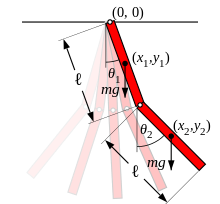I was playing around a physics simulation and I saw this. (One of my first questions , forgive if this question is too simple or has grammatical errors)
Here it is in action.
I wanted to figure out its time period as it is periodic motion, i also figured that they are performing rotation along the joints and I can use transition from 1 rotation frame from other, Also something more important is this image.So the rod 1 performs motion in a circle where as rod 2 performs motion in an ellipse and rod 3 performs some other periodic motion which i do not know.

I need help in understanding this motion and figuring out its time period. Thanks for the help in advance. (You can use Physion where User named Dimitri made this)





